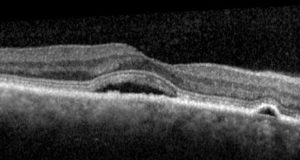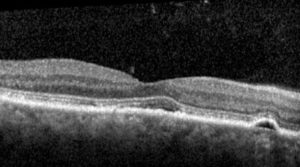Central Serous Chorioretinopathy (CSCR) is a common condition in which fluid accumulates under the central retina creating blurry vision. The retina, like the film in a camera, is responsible for vision. It is supported by other layers in the eye which provide nutrition and remove harmful waste products. To work to its fullest potential, the retina must be firmly attached to the Retinal Pigment Epithelium (RPE) which is directly beneath it.
In CSCR, a layer of fluid accumulates between the retina and RPE. The most common symptoms are:
- Blurred Vision
- Micropsia or smaller appearance of things
- Metamorphopsia or distorted vision
Most people make a full recovery within 1-4 months without treatment. Some, however, develop a more chronic form of the condition that can lead to permanent loss of vision.
In chronic cases, therefore, we consider treatment to prevent permanent damage. Treatment targets leaking blood vessels in the Choroid. Options include:
- Verteporfin photodynamic therapy
- Micropulse laser
- Thermal laser
- Oral medications
The oral medication Eplerenone has been mentioned as a plausible treatment for CSCR. Eplerenone is an aldosterone antagonist that was approved by the FDA for hypertension. It is similar to Spironolactone with fewer side effects. Eplerenone is well tolerated but can cause electrolyte imbalances in people with renal insufficiency and treatment should be monitored by your primary care physician. It works by blocking the mineralocorticoid receptors which helps restore the fluid balance and resorb sub-retinal fluid. Early pilot studies have shown moderate success and one prospective double-blinded study showed significant improvement with spironolactone compared to placebo. (Bousquet E. Retina 2015)
Recently I implemented Eplerenone therapy on some of my patients with chronic CSCR and have been pleased with the results. All patients have shown reduction in chronic fluid that was present under the retina and some with complete resolution. All patients have tolerated the medication well. While this is far from conclusive evidence and my data is preliminary, it is early affirmation of a possible alternative treatment option for this difficult to treat condition. I look forward to larger prospective studies with Eplerenone and will continue to track the progress of my patients. (See below for example)
Figure A. OCT scan of a patient’s right eye with Chronic CSCR and a pocket of fluid under the Retina.
Figure B. 1 month after initiation of Eplerenone therapy with almost complete resolution of sub-retinal fluid and improvement in vision.


